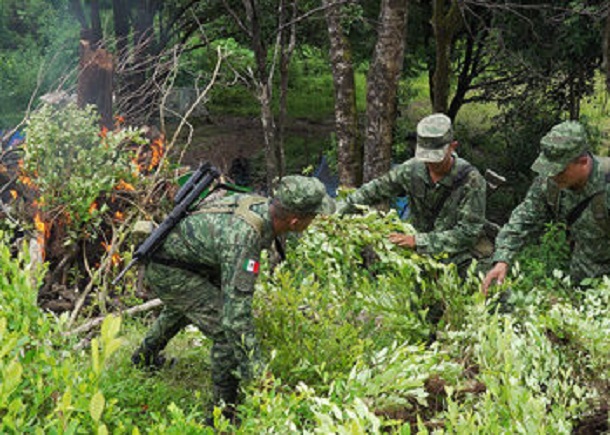GUERRERO, MEXICO.- A military helicopter flies over verdant mountains in southern Mexico, the scene of unusual coca crop discoveries that suggest drug cartels are adapting to shifts in the multimillion-dollar narcotics trade.
For years, poppies — the raw material for heroin — and marijuana have provided a livelihood for thousands of small farmers in the impoverished state of Guerrero, but in recent years, the growing US addiction crisis surrounding the potent synthetic drug fentanyl has caused opium demand and prices to fall.
The result is that Mexican traffickers are experimenting with growing coca leaves, whose production has historically been dominated by Bolivia, Peru, and Colombia.

“It’s an activity that hadn’t been detected here before,” said Colonel Carlos Javier Perez, who heads the unit in charge of destroying coca in Guerrero. “In a month and a half, we’ve found 27 plantations.”
Mexico’s coca fields are in their infancy, with a surface area of about 36 hectares eradicated in the past four years — a drop in the ocean compared with Colombia.
“Organized crime groups are trying to diversify their activities and experiment with coca planting,” Perez said, as soldiers uprooted the bushes by hand and burned them in the town of Atoyac de Alvarez.
Cocaine is hugely profitable. In Europe, 1kg can sell for about US$40,000.
It is a sum most farmers could only dream of in Guerrero, one of Mexico’s poorest states, which has endured years of violence linked to turf wars between drug cartels.
Mexican cartels have come to control almost the entire cocaine trafficking chain in Colombia.
Now coca crops are also flourishing in Honduras and Guatemala, once just transit points for the drug from South America.
In the Mexican case, “it is linked to the production of fentanyl,” said Libertad Arguello, an expert at the Colegio de Mexico Institute of higher education. “It’s no coincidence that coca leaves began to be cultivated.”
The Mexican government reported the first coca plantation discoveries in February 2021.
Mexican President Andres Manuel Lopez Obrador said that criminal groups were experimenting with the crop.
The 1-hectare field found in Guerrero had a small irrigation system.
A few meters away, the soldiers also found an improvised laboratory, tools, chemicals, gasoline, and clothing left behind by those in charge.
To reach the crops, the military traveled nearly an hour in off-road vehicles and on foot through dense vegetation.
The soldiers must explore the area on foot because it is almost impossible to spot the coca plants from the air, Perez said.
In the laboratory where the coca paste was produced, a sleeping bag, blankets, and a cap had been abandoned by workers, who the military said fled when they saw the troops.
The paste, obtained by mixing chopped leaves with lime, cement, gasoline, and ammonium sulfate, is usually taken elsewhere to be turned into cocaine, Perez said.
Source: INFOBAE






